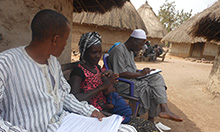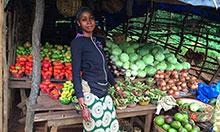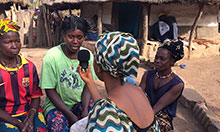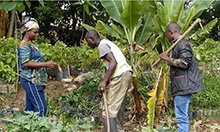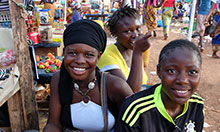Informing Social and Behavior Change Programming
Introduction
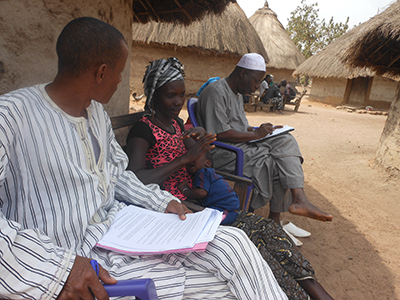
Background
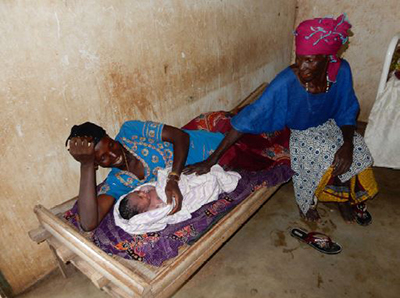
In 2015, the United States Agency for International Development (USAID) Bureau for Food Security provided post-Ebola response funding to the Strengthening Partnerships, Results, and Innovations in Nutrition Globally project (SPRING) through USAID/Guinea, as part of wider efforts within the region to spur recovery from the Ebola crisis of 2014–2015. SPRING conducted an initial assessment between July–October 2015 to examine the impact of the Ebola crisis on services, agricultural production, and food security in Guinea, and to understand the determinants of high levels of undernutrition in the country. This assessment brought nutrition, agriculture, and social and behavior change communication (SBCC) experts together to review the current context of nutrition, health, and nutrition-related programming, and nutrition-sensitive agriculture in the country, with an emphasis on women and children under 2 years of age. Findings showed that the food security and the nutrition situation had significant challenges even before the crisis, and that the Ebola epidemic had badly disrupted health and agricultural services.
Based on the full range of findings and recommendations from the initial assessment, USAID/Guinea invited SPRING to design and implement a two-year program. SPRING’s primary goal in Guinea was to contribute to improving dietary diversity among households with pregnant and lactating women and children under the age of 2 in Faranah prefecture. SPRING supported the overarching Feed the Future objectives of improving nutritional status, leveraging agricultural productivity, and improving income generation.
The assessment was to inform the development of SBCC activities and materials to promote specific behaviors related to maternal, infant, and young child nutrition (MIYCN); nutrition-sensitive agriculture; and hygiene behaviors in the prefecture of Faranah. This is in accordance with the detailed implementation plan (DIP) that SPRING developed with Winrock International and with faculty members of the Institut Supérieur Agricole et Vétérinaire (Superior Agriculture and Veterinary Institute [ISAV]) in Faranah, prior to the assessment. For the nutrition-sensitive agriculture component of the formative research, SPRING worked with ISAV faculty and Winrock staff to review 16 different crops and select two nutrient-dense agricultural products to help to fill nutrition gaps in the first 1,000 days of life (targeting pregnant and lactating women and children 6–23 months). The two key crops selected were sweet potato leaves (high in vitamin A) and cowpeas (high in protein). The team used the following criteria for selection:
The products to be promoted should—
- Fill an identified nutrient gap in the diet of pregnant and lactating women and/or in children 6–23 months. The most prominent gaps were vitamin A, protein, and iron.
- Be available year-round, either through conservation or by having more than one production cycle.
- Have its entire value chain within the region of Faranah.
- Be consumable in various forms without altering its nutritional value.
To better understand community-level behaviors relating to dietary intake and water, sanitation, and hygiene (WASH) practices, the SPRING team did a transect walk through Beindou village in the prefecture of Faranah. The team then better understood the context by observing day-to-day community practices, behaviors, and activities; this exposure was helpful in adapting the formative research tools.
Research Objectives
The overall objective of the formative research was to inform the SPRING team’s understanding of the maternal, infant, and young child nutrition (MIYCN) and hygiene behaviors among rural households in the prefecture of Faranah, including the socio-cultural and economic factors—such as gender inequality and male engagement— that contribute to nutrition and agriculture practices.
Informed by the initial assessment from 2015, discussions with key informants, and information gleaned from the transect walk, the team developed the following specific research objectives:
- To identify existing family relationships in terms of decision making: Who makes decisions about health and nutrition?
- What are the barriers and enablers for the following practices?
- Mothers/caregivers give children 6–23 months porridge enriched with vitamin A-rich foods, such as sweet potato leaves, year-round.
- Mothers/caregivers give children 6–23 months porridge enriched with protein-rich foods, such as niébé (cowpeas) year-round.
- Mothers/caregivers of children 6–23 months wash their hands with soap and water1 at the critical times.
- Households with children 0–23 months install and use a tippy tap to facilitate handwashing with soap and water.
- 3. To identify current household hygiene practices for children 0–23 months old (to reduce the risk of environmental enteropathy).
- To identify opportunities for greater involvement and support by fathers for MIYCN behaviors.
For objectives 2.1 and 2.2, the recommended behavior—based on Essential Nutrition Actions2—is to supplement children’s porridge with any vitamin-A rich or protein-rich foods. However, given the project’s intention to promote the production of sweet potato leaves and cowpeas, researchers prioritized the consumption of these two commonly available products.
Ethical Considerations
John Snow, Inc.’s institutional review board examined the protocol and instruments, which determined that the activity was exempt from human subjects’ oversight.
Methodology
The methodology was adapted to the Faranah context in Guinea based on the protocol and instruments presented in SPRING’s Community Video for Nutrition Guide.3 The SPRING team—Phil Moses, Marjolein Moreaux, and Abdoul Khalighi Diallo—refined the research questions and instruments from the initial 2015 assessment. To accommodate for the crops selected as the priority crops for SPRING’s nutrition-sensitive agriculture work (cowpeas and sweet potato leaves), the team reduced the number of questions about MIYCN and focused more on nutrition-sensitive agriculture. The team added a structured observation activity to examine current household hygiene practices and a daily activities listing exercise with men and women to identify opportunities for greater male involvement in child nutrition.
Data Collection Methods
SPRING planned the following data collection methods for each of the two communities:
- Focus group discussions (FGD) with mothers of children 6–23 months old to examine family relationships in terms of decision making, and to identify barriers and enablers to (a) feeding porridge enriched with sweet potato leaves and/or cowpeas to children 6–23 months old year-round; (b) washing hands at the critical times with soap and water; and (c) installing and using a tippy tap handwashing station. SPRING also used these FGDs to collect data on current household hygiene practices pertaining to children 0–23 months. Each FGD included eight mothers.
- FGDs with fathers of children 6–23 months old to get a more meaningful male perspective on the questions mentioned above in the FGDs with mothers, and to triangulate data.
- In-depth interviews (IDI) at the individual level with a selection of mothers of children 6–23 months old (distinct from the FGD above), with grandmothers of children 0–23 months old, and with fathers of children 0–23 months old, to examine the same questions mentioned above.
To broaden the scope of the data, the team selected grandmothers and fathers who were not associated with the mothers in the FGD or the IDI. The purpose of conducting both FGD and IDI with mothers and fathers was to provide more in-depth information than might be gleaned from a FGD. We conducted the IDI with mothers before conducting the FGD and used the information to adjust questions for the FGDs. We conducted IDIs with grandmothers to triangulate information provided by mothers.
- Structured observation of households with children 0–23 months to collect data on current household hygiene practices pertaining to children 0–23 months old (to reduce the risk of environmental enteropathy). The observer remained in the home for several hours and, using a structured observation checklist, noted specific hygiene-related behaviors.
- A daily activities listing exercise to identify opportunities for more male involvement in the care and nutrition of children. This exercise consisted of one FGD with mothers of children 6–23 months and one FGD with fathers of children 6–23 months. Each group was asked to list all the activities at various times during a typical day that a man in their village conducts and how much time each activity takes—this is sometimes referred to as a “Gendered Workday Calendar.” Then, the group creates a similar list for activities that women conduct. After completing their lists, the two groups meet together. The facilitator helps each group review the other’s lists, and to point out and discuss discrepancies and shared perceptions of the division of work between men and women. The facilitator then helps the participants identify together ways men can support child nutrition, which are acceptable to both men and women. To reduce respondent bias, SPRING selected fathers who were not the spouses of the women in the corresponding FGD. Each exercise included eight women and eight men. Table 1 presents each data collection method with its corresponding assessment objectives.
Table 1. Assessment Objectives and Questions with Corresponding Data Collection Methods
| Assessment Objectives | FGD mothers | IDI mothers | IDI with grandmas | FGDI with fathers | IDI with fathers | Hygiene observations | Daily activities listing exercise s with moms & dads |
|---|---|---|---|---|---|---|---|
| 1. Identify existing family relationships in terms of decision making | |||||||
| 2. To identify barriers and enablers to the following practices: | |||||||
| 2.1 Enriching porridge with sweet potato leaves year-round | |||||||
| 2.2 Enriching porridge with niébé (cowpeas) year-round | |||||||
| 2.3 Washing hands at the critical times with soap and water | |||||||
| 2.4 Installing and using a tippy tap | |||||||
| 3. To identify current practices pertaining to baby-WASH/ environmental enteropathy | |||||||
| 4. To identify opportunities for greater involvement and support by fathers for MIYCN behaviors |
Data Collection Instruments
The data collection instruments comprised semi-structured interview guides using open questions for FGD and IDI, a discussion guide for the daily activities listing exercise, and a household hygiene observation checklist. As mentioned above, SPRING adapted the guides for FGDs and IDIs from Senegal’s French versions. (Please see Annex 3-A. and Annex 3-B). The daily activities listing exercise guide was translated into French and adapted to the local context based on an exercise from the Oxford Gender Training Manual4 (See Annex 3-C). SPRING translated a household hygiene observation checklist from Save the Children US5 into French and then adapted it to the local context (see Annex 3-D). During the one-day training for the research team, the interviewers from research partner—Institut Supérieur Agricole et Vétérinaire (Superior Agriculture and Veterinary Institute [ISAV])— translated the FGD and IDI guides into Malinke. Because very few people actually read and write Malinke, the team determined it was more practical to keep the instruments in written French and to write directly on the instruments the standard Malinke words that they agreed to for key terms. The interviewers conducted mock interviews with each other in Malinke to test out the tools and to identify any needed revisions. The team members who would conduct the structured observations reviewed the French translation of the household hygiene checklist to ensure that all the terms were clear. The SPRING team then revised and finalized all the tools.
Sampling
The team selected a purposive sample of two villages for data collection: Beindou and Hérémakono. ISAV faculty members suggested these two communities because they are roughly representative of the two slightly different ethnic groups that dominate the rural areas outside Faranah: Beindou, predominantly by the Sankaran ethnic group; and Hérémakono, predominantly by the Djallonkadou ethnic group. Both communities speak Malinke. Beindou is about 30 km east of Faranah and Hérémakono is about 45 km southwest of Faranah. Each community is 30–60 minutes from Faranah, depending on road conditions. A convenience sample of informants was selected by ISAV’s agriculture extension point of contact in each village. The previous day each point of contact received detailed instructions by phone, including criteria for the selection of informants, the local venue for interviews, and homes to be selected for structured observations.
Data Collection and Analysis
Participants in the interviewer training included seven men and two women from the ISAV faculty and two Winrock staff members. The SPRING team observed the participants during the training and selected the best eight to be members of the data collection team. The final team comprised seven ISAV faculty members and one Winrock staff member. Each team had four members, plus one SPRING coordinator; one team was assigned to each community. The coordinator was to observe the data collection activities, provide feedback to the other team members on their conduct of the activities, and ensure the quality of the data. Because of their work history in the communities and their familiarity with the culture—many are native to the area—members of the data collection team also played a role as key informants. They helped interpret the data and also provided extra observations to help round out or provide background information about information provided by the villagers.
The teams collected data over three workdays: February 19, 20, and 22, 2016. The teams began the first day of data collection with IDIs with mothers and grandmothers to inform the facilitation of the FGDs. Because interviewers were inexperienced in the area of nutrition, the coordinators observed that data collection would take longer than planned. Therefore, the coordinators decided to eliminate the planned IDIs with fathers to allow time for the FGDs with the fathers. On the second day of data collection, the teams conducted the first of two FGDs with mothers and five hygiene observations: one in Beindou and three in Hérémakono. Teams conducted one FGD with fathers in each community on day two. On the third day of data collection, the teams conducted the second of two FGDs with mothers and the daily activities listing exercise in each of the two villages. Please see Table 2 for a list of daily activities.
Table 2. Activity Calendar for Formative Research
| Date | Activity |
|---|---|
| February 12 | Travel to Faranah from Conakry. |
| February 13 | In briefing with partners. Review data collection tools. |
| February 14 | Transect walk through Beindou. |
| February 15 | Detailed implementation planning workshop. |
| February 16 | Detailed implementation planning workshop. |
| February 17 | Detailed implementation planning workshop and finalize data collection plan. |
| February 18 | Training of interviewers. |
| February 19 | Team 1 – Hérémakono: IDI with mothers and grandmothers. Team 2 – Beindou: IDI with mothers and grandmothers. |
| February 20 | Team 1 – Hérémakono: FGD with mothers, FGD with fathers, and hygiene observations. Team 2 – Beindou: FGD with mothers, FGD with fathers, and hygiene observations. |
| February 21 | Review of field notes; identification of key themes. |
| February 22 | Team 1 – Hérémakono: FGD with mothers; daily activities listing exercise. Team 2 – Beindou: FGD with mothers; daily activities listing exercise. |
| February 23 | Data analysis, identification of preliminary findings; report out to partners. |
| February 24 | Travel to Conakry. |
Each FGD was conducted by a team of one facilitator, one note taker, and one observer. The note taker wrote down FGD informants’ comments directly on the FGD guide. After completing the FGD, the facilitator, note taker, observer, and coordinator discussed the responses and revised the notes, as needed. The coordinator also provided feedback to the other members on how to improve the next FGD.
Each IDI was conducted by one interviewer and one note taker. The note taker wrote down the IDI informants’ comments directly on the semi-structured interview guide. After completing the IDI, the interviewer, note taker, and coordinator discussed the responses and revised the notes, as needed.
The daily activities listing exercises were conducted with men and women simultaneously, in separate places; each group included a facilitator and a note taker. After completing the listing separately, by sex, both groups met in a large group. Each large group had one facilitator, one note taker, and one observer. (See Annex 2 for an example of the output from this exercise.)
One team member in each community conducted the hygiene observations. Each observation lasted two to three hours. The observer visited the selected household and observed the hygiene behaviors in the home. At the end of each hour, the observer noted responses/observations on the detailed observation checklist. After completing an observation, the observer met with the coordinator to review the notes from the checklist, clarify the answers, and revise the checklist, as needed.
As compensation for their time, SPRING provided each informant involved in any data collection activity with a light meal and a bar of soap. Table 3 displays the total number of each data collection activity, by community, with the total numbers of informants. Table 4 shows a breakdown of the informants, by category.
Table 3. Data Collection Plan Summary
| FGD mothers | In depth interviews mothers | IDI with grandmas | FGD with fathers | Hygiene observations | Daily activities listing exercise s with moms & dads | Total data collection activities | Total number of informants by community | |
|---|---|---|---|---|---|---|---|---|
| Beindou | 2 completed/ 2 planned | 2/2 | 2/2 | 1/1 | 2/2 | 1/1 | 10 | 46 |
| Hérémakono | 2/2 | 2/2 | 2/2 | 1/1 | 3/2 | 1/1 | 11 | 47 |
| Total number of activities completed | 4/4 | 4/4 | 4/4 | 2/2 | 5/4 | 2/2 | 20/22 | |
| Total number of informants | 32 | 4 | 4 | 16 | 5 | 32 | 93 |
Table 4. Number of Formative Research Informants
| Focus Group, IDI, and Hygiene Observations and Daily Activities Exercise | Villages | |
|---|---|---|
| Beindou | Hérémakono | |
| Total participants | 46 | 47 |
| 1. Mothers of children ages 6 months to 2 years | 28 | 29 |
| 2. Fathers of children ages 6 months to 2 years | 16 | 16 |
| 3. Grandmothers of grandchildren ages 6 months to 2 years | 2 | 2 |
The teams analyzed the qualitative data in two steps. At the end of each day, the team from each village met to review their notes and to conduct an initial analysis using an analysis matrix to summarize responses and their own observations (see Annex 1.) After completing all the data collection, the two teams met to share their results and to consolidate the results from both villages, including their observations (using a consolidation form). They made special note of points of convergence and divergence among responses and observations. The SPRING team was involved in all levels of the analysis and used these analysis matrices and consolidation forms to identify the initial findings. The SPRING team shared these findings with the data collection team to receive their feedback, they shared the initial findings with the Winrock management team for their comments, and then finalized the findings.
Findings and Recommendations
The formative research aimed to identify current practices around key feeding and hygiene behaviors and male involvement in child nutrition, as well as barriers and enablers to the uptake of key recommended nutrition-specific behaviors and nutrition-sensitive agriculture practices. Based on these findings, the formative research team created program recommendations for SPRING/Guinea to improve the uptake of the recommended behaviors.
Family Relationships and Decision Making for Maternal and Child Nutrition
In many parts of West Africa, when a woman marries, she moves into the compound of her husband. The motherin-law has a strong influence over practices related to the care and nutrition of her daughter-in-law while she is pregnant, as well as over the care of the infants and children. Women, in general, perceive their role as being responsible for preparing meals; caring for, feeding, bathing, and dressing children; and keeping the home clean. Women often cultivate their own gardens and sell the produce to cover expenses for the food and health of the family. In the area around Faranah, family compounds are usually not walled and women go to and from the market, fields, or other places without, necessarily, asking the husband for permission. A woman’s mother-in-law, sisters-in-law, mother, sisters, or older daughters often help with household chores and care for the children. Women are also expected to work on the husband’s plots of land (usually of rice). During high workload times (planting, harvesting, etc.), the entire family is often expected to work long hours in the field. A nursing mother will often carry her nursing child with her to the fields when she needs to work. Husbands and fathers-in-law tend to support a mother by providing rice for the family and paying for key purchases or fees for health care and medicines. Several women reported that their husbands and fathers-in-law also helped to feed or watch children when the mother had to leave the home. Some women mentioned that a barrier to handwashing with soap is that their husbands do not want to provide the money for the extra soap. Significant family purchases tend to be the domain of the husband or father-in-law. Husbands report that they play a more active role in the raising of older children; for example, by walking them to school or instructing them in Koranic verses. They also reported being very interested in helping to improve the nutrition of their wife and baby. Several mentioned that they would not object to adding foods, such as cowpeas or sweet potato leaves, to a baby’s porridge as long as they knew why it was important to do so.
Members of the data collection team shared that, while many men help their wives, in many cases a man simply provides his wife with a supply of rice once a year and then leaves the rest of the household purchases and household chores to the wife. They mentioned that this seems to happen more frequently when the man has multiple wives.
Feeding 6–23 Months Old
Priority Behaviors to be Promoted Among Beneficiaries6
- Mothers/caregivers provide children 6–23 months with porridge enriched with vitamin A-rich foods, such as potato leaves year-round
- Mothers/caregivers provide children 6–23 months with porridge enriched with protein-rich foods, such as niébé (cowpeas), year-round.
Current Practices
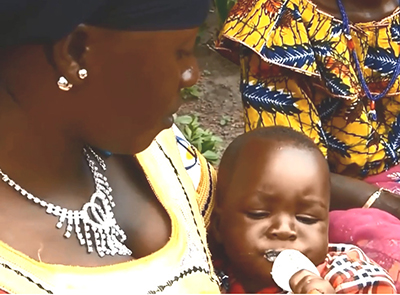
The formative research assessment explored the factors that influenced whether households could adopt these two recommended practices. Most informants knew that children between 6 months and 2 years need to eat many times a day; they said their children eat three times a day, generally, and a minimum of four times per day during the rainy season. In addition to breastfeeding, children in both villages may receive rice, bouillie (porridge), and bread for meals. Mothers in Beindou confirmed their children occasionally will have eggs and mothers in Hérémakono also indicated that they give their children soup with fish or meat. Mothers indicated that they begin giving children food from the family meals after they are 12 months old.
Snacks include small cakes, bananas, oranges, groundnuts, and cookies or candy. Children between 6 months and 2 years in Hérémakono are regularly given Café au lait and herbal tea to drink. Food is rarely enriched with supplements. In Beindou, mothers indicated that their mothers-in-law occasionally oppose giving children anything other than breastmilk and regularly oppose adding supplements because they believe children under 2 Photo credit: SPRING years cannot digest it. Many informants echoed fears about offering foods other than thin pap or bouillie de riz ou de mais (rice or corn porridge) and breastmilk to babies 6–12 months, specifically they are afraid the baby will choke because they don’t have all their teeth and can’t chew; and for fear that a baby’s stomach can’t digest other foods.
All mothers interviewed indicated that children between 6 months and 2 years eat from their own plate, often at different times from the rest of the household. Grandmothers are significantly involved in all aspects of feeding for children 6–23 months old, and older siblings will usually feed their younger siblings if their mother and grandmother are both unavailable.
Barriers and Enablers to Enriching Porridge with Sweet Potato Leaves And/Or with Cowpeas (Niébé) Year-Round
Enablers: Families already commonly use cowpeas and sweet potato leaves. They are plentiful during the rainy season and informants said they would be willing to add sweet potato leaves or cowpeas to the food of children 6–23 months old.
Barriers: Informants lacked knowledge about the nutritional value of cowpeas and sweet potato leaves, and said they lacked the right skills and techniques for preparing both for a child. Sweet potato leaves and cowpeas are scarce during the dry season. Informants said they often lack the financial resources for either buying these products or for growing them in their home gardens. Informants said they lacked skills and instruction on how to grow cowpeas and sweet potato leaves during the dry season. Some fathers said they would not agree to adding foods to the porridge of a 6–12 month old unless they knew why the specific foods are important.
Recommendations to Program Implementers
- Develop community videos and other SBCC materials around feeding sweet potato leaves and cowpeas to pregnant and lactating women and children 6–23 months old, year-round.
Materials should—- target mothers, grandmothers, and fathers
- especially promote feeding sweet potato leaves and cowpeas between 6–12 months
- communicate the proper thickness of porridge for children 6–12 months old
- include proper preparation techniques of cowpeas and sweet potato leaves for children under 23 months old.
- Develop highly engaging demonstrations (such as cooking demonstrations) on—
- the proper ways to prepare sweet potato leaves and cowpeas.
- Conduct agricultural trials of different varieties of sweet potatoes and cowpeas in home gardens during the dry season (in targeted communities).
- Develop a technical manual for agricultural extension agents on best practices for home production during the dry season, postharvest storage, and transformation (food preparation and processing). Include recipes appropriate to children 6–23 months old and pregnant/lactating women. The manual should address ways to minimize loss to pests/diseases during the dry season. Promote the use of the technical manual among agricultural extension agents.
Household Hygiene Practices
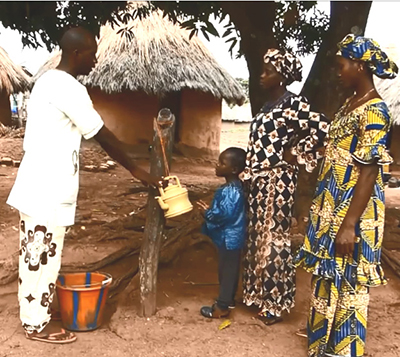
Priority Behaviors to Be Promoted among Beneficiaries
- Wash hands with soap and water at critical times.
- Install and use a handwashing station (tippy tap).
- Keep children 6–23 months old from coming into contact with animal feces.
- Ensure that children 6–23 months drink only properly treated water.
Current Household Hygiene Practices
Adults tend to wash their hands with soap only before the main meal. They sometimes wash their hands without soap after cleaning the child after defecation, but usually do not wash their hands with or without soap after relieving themselves. The men are responsible for buying the soap for the family, although sometimes the women buy it. The use and conservation of soap are the woman’s responsibility. Few homes have access to latrines. Mothers were observed disposing of a child’s feces in a latrine or a hole. No human feces were observed inside the villages. Children were observed defecating on the floor of the house or in outdoor living areas. Most people use the bush as a toilet, even if they have access to a latrine, and most do not have water for handwashing near where they defecate. Some informants said they wash their hands when they come back. However, no handwashing stations were observed in any households seen during the transect walk or during direct observation. Informants also report that they are not aware of anyone currently having a household handwashing station. Many mothers were observed washing their hands or the baby’s hands, but not with soap. In both communities, most people have access to water within a short walk of their home.
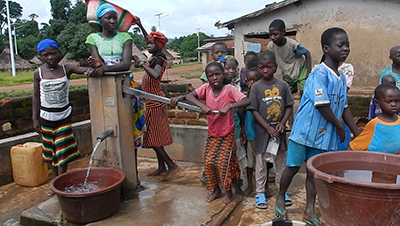
Animal feces were often visible in children’splay areas. Toddlers were observed to be near cows, chickens, goats, and sheep. Humans and animals live together and all courtyards have animals openly moving about; animals are not locked up or attached somewhere, at least not during the day time. Mothers did not keep toddlers separated from animals or other dirty areas.
Most people draw their drinking water from borehole wells. No informants report treating their water at home in any way, not even the water given to babies. Health care workers who were interviewed during an unplanned visit to the Hérémakono health center were unaware of any sensitization or promotion of treating water in the household. While the health center had a small stock of water treatment solution (chlorine-based) for use at the health center, commercial water treatment products were not found in the local market.
Barriers and Enablers to Washing Hands at the Critical times with Soap and Water, and to Installing and Using a Simple Household Handwashing Station
Enablers: Because of the antiEbola efforts, informants know when they should wash their hands with soap and water and why. Informants are familiar with handwashing stations and all have used the ones available in public places (mosques, schools, etc.). Informants reported that some individuals installed household handwashing stations (tippy taps) spontaneously during the epidemic.
Barriers: Since the end of the Ebola epidemic, informants report a general relaxation of vigilance around handwashing. In villages, plastic bottles for tippy taps are not easy to get (the sous-préfet of one town asked the team to give him their empty water bottles). People report that buying extra soap is hard to afford. Some mothers thought that it would be hard to convince their husband to pay for the extra soap needed for handwashing. People are not aware that they can wash their hands effectively with water and ashes.
Recommendations to Program Implementers
Develop highly engaging demonstrations and community videos on—
- the importance of handwashing with soap at the critical times and how to wash hands correctly
- creating handwashing stations using locally available substitutes for plastic bottles (e.g., gourds or ceramic bowls).
Opportunities for Greater Involvement and Support by Fathers for MIYCN Behaviors
Priority Behaviors to Be Promoted among Beneficiaries
Fathers support MIYCN behaviors.
Current Practices
The times during the day when men are available to help with the care of children under 2 years vary, depending on the specific livelihood activities of the family (e.g., watching the children while the mother milks cows). Men expressed a willingness to help in all ways except for changing and washing the baby. Women expressed a willingness to receive help from their husbands in all tasks, except for cooking, changing and bathing children, and milking cows.
Recommendations to Program Implementers
Community videos on various topics feature husbands supporting MIYCN behaviors. Examples include building handwashing stations, arranging the family tasks to ensure that his wife has the time to breastfeed, support increased meals and a diverse diet for his wife during pregnancy and while lactating, and helping to feed and care for children.
Limitations
This formative research assessment had a number of limitations that could affect the results. The process of selection of the communities may have limited the representativeness of the sample. Because of time and resource constraints, the team had to limit eligible communities to those that were easily accessible by road and where ISAV faculty had active points of contact willing to support data collection on short notice. Each of the two villages selected was also a sub-prefecture with a population of about 4,000, a health center, and a government sub-prefecture’s office. Thus, the two sites selected were from among more centrally located communities. The findings may not reflect the realities of families living in more remote communities or those where ISAV’s presence is not very strong. Also, because of time constraints, informants were recruited by the ISAV point of contact in each community (convenience sample). The informants were most likely selected from among individuals and households that were known to and/or connected with each point of contact. In addition, participating in data collection activities represented an investment of the informants’ time. This means that the realities of individuals who are less well-connected to the community leadership, or those who lacked the time to participate, might not be reflected in the findings. The data collection team members are agriculture experts. No team members present in the field—with the exception of the SPRING staff member from Washington—had any training in health or nutrition. Therefore, they may have missed cues for follow-up questions or clarification during FGDs and IDIs. Also, this lack of familiarity with the topic required more time than anticipated, resulting in the cancellation of IDIs with fathers. Therefore, the point of view of men was less well-represented than planned. Finally, the SPRING staff member from Washington speaks and understands French, but not Malinke. While he relied on other team members to interpret for him while observing interviews and FGDs, his capacity to correct errors or to ask follow-up questions was limited. This might have limited the capacity to ensure the quality of the data. These limitations are to be expected when conducting rapid formative research. That said, the results of this assessment have proven to be central to program planning and have provided timely actionable recommendations that allowed for quality implementation of SBCC activities within the project timeframe.
To view the annex, please download the full report above.
Footnotes
1 Critical times for handwashing with soap and water include (a) after using the toilet/defecating, (b) after cleaning a baby’s bottom or changing diapers, (c) after handling animal feces, (d) before preparing food for a baby, and (e) before feeding a baby.
2 Guyon, A., V. Quinn, J. Nielsen, and M. Stone-Jimenez. 2015. Essential Nutrition Actions and Essential Hygiene Actions Reference Materials on Key Practices: Community Workers. https://coregroup.org/wp-content/uploads/mediabackup/documents/Resources/Tools/ENA_EHA/ENA_EHA_Reference_Material_Community_Workers.pdf
3 Granger, Kristina, Peggy Koniz-Booher, Lakshmi Iyer, Avinash Upadhyay, Rikin Gandhi, and John Nicholson. 2015. Community Video for Nutrition Guide. Arlington, VA, and New Delhi, India: Strengthening Partnerships, Results, and Innovations in Nutrition Globally (SPRING) project and Digital Green. https://www.springnutrition.org/sites/default/files/publications/series/spring_community_video_for_nutrition_guide.pdf
4 Williams, S., and Mwau Seed. The Oxford Gender Training Manual. 1994. “The 24-hour day” pp179–181. https://policypractice.oxfam.org.uk/publications/the-oxfam-gender-training-manual-141359
5 Sara, S. Observation Checklist: Infants & Young Children 0-2 Years, Save the Children US (Email from S. Sara 2/11/2016).
6 Based on the findings of the initial needs assessment, and of this formative research assessment, SPRING recommended that nutrition activities in Faranah focus on improving a number of specific behaviors related to feeding young children, hygiene, and male involvement. These priority behaviors are listed at the top of each section.
References
Granger, Kristina, Peggy Koniz-Booher, Lakshmi Iyer, Avinash Upadhyay, Rikin Gandhi, and John Nicholson. 2015. Community Video for Nutrition Guide. Arlington, VA, and New Delhi, India: Strengthening Partnerships, Results, and Innovations in Nutrition Globally (SPRING) project and Digital Green. https://www.springnutrition.org/sites/default/files/publications/series/spring_community_video_for_nutrition_guide.pdf
SPRING. 2015. Guinea Nutrition Assessment. Arlington, VA: Strengthening Partnerships, Results, and Innovations in Nutrition Globally (SPRING) project.
SPRING. 2016. Informing Video Topics and Content on Maternal, Infant, and Young Child Nutrition and Handwashing: Situational Analysis and Formative Research in Maradi, Niger. Arlington, VA: Strengthening Partnerships, Results, and Innovations in Nutrition Globally (SPRING) project. https://www.springnutrition.org/sites/default/files/publications/reports/niger_formative_research-web.pdf
Williams, S., and Mwau Seed. The Oxford Gender Training Manual. 1994. “The 24-hour day” pp179–181. https://policy-practice.oxfam.org.uk/publications/the-oxfam-gender-training-manual-141359
